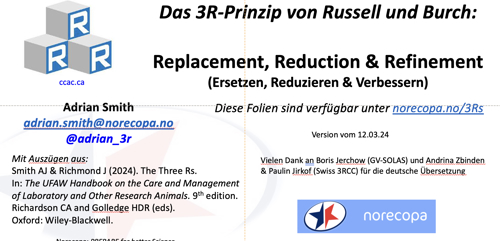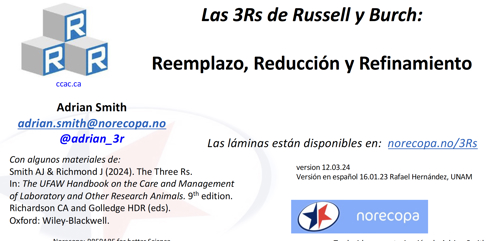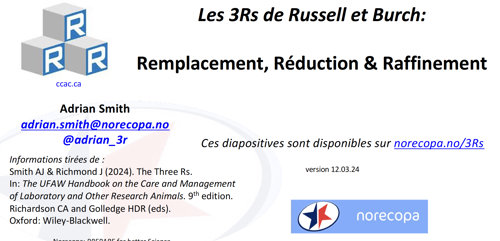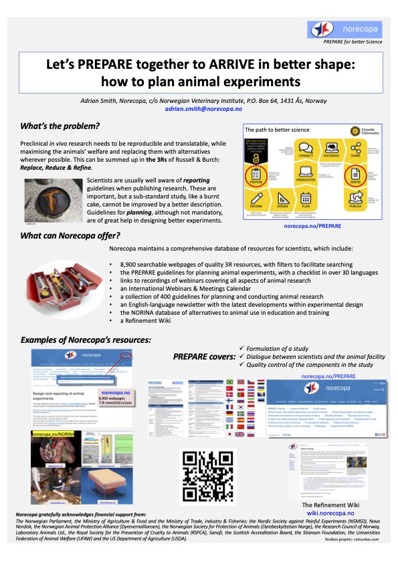The Three Rs
William Russell and Rex Burch developed the concept of the 3Rs during the 1950s, and described them in their book The Principles of Humane Experimental Technique, published in 1959:
An abridged version of the book, by Michael Balls (The Three Rs and the Humanity Criterion), is also available online.
The PREPARE guidelines for planning animal research and testing contain links to many resources which can be used to improve applications for animal experiments and implement the 3Rs.
Download a slide deck about the 3Rs (pdf).
If you would like the Powerpoint version to use in your teaching, please email Adrian Smith.
N.B. this slide deck may be updated from time to time. Latest version: 12.03.24.
German version (thanks to Boris Jerchow, Andrina Zbinden and Paulin Jirkof for the translation):
Spanish version (thanks to Rafael Hernández González for the translation):
French version (thanks to Zia Salmon for the translation):
Czech version (thanks to Kristina Kejlova for the translation):
Russell and Burch's definitions were:
Replacement means the substitution for conscious living higher animals of insentient material (Partial Replacement if animals are still used, and Total Replacement if animals are not used).
Reduction means reduction in the numbers of animals used to obtain information of a given amount or precision.
Refinement means any decrease in the incidence or severity of inhumane procedures applied to those animals which still have to be used.
Their definition of Replacement, in particular, is very different to that held by many people today, who consider replacement to be solely the use of non-animal material. For example, according to Russell and Burch's definition, an acute experiment (also known as non-recovery, i.e. an experiment performed on a totally anaesthetised animal which is killed under the anaesthetic at the end of the experiment) is a Partial Replacement method, not Refinement.
The November issue of the journal Animal Welfare in 2005 was dedicated to the 3Rs.
Many definitions of the 3Rs have been developed since Russell and Burch first described them (see below), and some differ significantly from the original definitions (Tannenbaum & Bennett, 2015).
Those working under the EU Directive 2010/63/EU should read carefully the descriptions of the 3Rs on the Commission's own website, and especially their definitions of Refinement and Replacement. The Commission does not divide Replacement into Partial and Complete - partial replacement as defined by Russell & Burch is Refinement according to the Commission.
The UK organisation NC3Rs has re-defined Russell and Burch's definitions so that they are more reflective of contemporary scientific practice and developments. They have also created a self-assessment tool and an introductory video for training purposes, and have written a blog to explain their rationale behind the need to take a fresh look at the concept.
Currently, the 3Rs are often understood as:
Replacement alternatives: methods which permit a given purpose to be achieved without conducting procedures on animals
Reduction alternatives: methods for obtaining comparable levels of information from the use of fewer animals in scientific procedures, or for obtaining more information from the same number of animals
Refinement alternatives: methods which alleviate or minimise potential pain, suffering or distress, and which enhance animal well-being
The 3Rs were primarily formulated to improve the humanity of animal experiments (i.e. to improve animal welfare), although application of Refinement will often also improve an experiment's validity.
The Three Vs have been proposed specifically to improve the validity of animal experiments.
The Three Ss have been proposed to ensure that commonsense and critical anthropomorphism are also applied.
Smith & Richmond (2024): The Three Rs. In: UFAW Handbook on the Care and Management of Laboratory and other Research Animals
3Rs Certificate Course produced by the 3Rs Collaborative
Further thoughts about the 3Rs
In their book (chapter 7 on Refinement), Russell and Burch emphasised the order in which the 3Rs should be addressed:
'Suppose, for a particular purpose, we cannot use replacing techniques. Suppose it is agreed that we shall be using every device of theory and practice to reduce to a minimum the number of animals we have to employ. It is at this point that refinement starts, and its object is simply to reduce to an absolute minimum the amount of distress imposed on those animals that are still used.'
Since the days of Russell and Burch, many new techniques have been developed which are not directly replacements for existing animal models, but which prevent animal use. These are referred to as New Approach Methodologies or Non Animal Methods (NAMs) and include cell cultures, computer simulations and organs-on-a-chip. This creates the need for scientists to adopt a new mindset: is it necessary to model the entire organism at once? In many cases it may be more than adequate to model just one body, tissue or cell system, using a NAM. If none of these meet the research objectives and the scientists is considering using an animal model, a search for animal replacements is then the next step.
3R Centres
There are now many 3R Centres in existence. Norecopa maintains an interactive global map of 3R Centres.
EU3Rnet is a network of European centres that promote one or more of the 3Rs.
Retter et al. (2024): 3R centres contributions to change animal experimentation: A field report from Charité 3R, the 3R centre of a medical faculty
Lauwereyns et al. (2024): Toward a common interpretation of the 3Rs principles in animal research
Development of the 3R concept
According to Russell and Burch, the ultimate aim of the 3Rs was to abolish inhumanity (or distress), and thereby achieve humanity, which explains the title of their book. They distinguished between direct and contingent inhumanity. Direct inhumanity is 'the infliction of distress as an unavoidable consequence of the procedure employed, as such, even if it is conducted with perfect efficiency and completely freed of operations irrelevant to the object in view'. Contingent inhumanity (usually referred to today as contingent suffering) is 'the infliction of distress as an incidental and inadvertent by-product of the use of the procedure, which is not necessary for its success'. Examples of contingent inhumanity are poor housing and handling.
Russell & Burch wrote:
The greatest scientific achievements have always been the most humane and the most aesthetically attractive, conveying that sense of beauty and elegance which is the essence of science at its most successful.
Development of interest in the 3Rs
The evolution of the Three Rs tenet has been described in detail (Balls, 1996, 2007, 2009; 2014; Balls et al., 1995; Russell, 2005, Hubrecht & Carter, 2019). The concept was developed as part of a project initiated by the Universities Federation for Animal Welfare (UFAW) in 1954, consisting of interviews with researchers about animal research, with the aim of improving upon the routines of the day. The word ”alternatives” was deliberately not used in the invitation, to avoid the risk of researchers declining to participate, which instead described ’a review of progress in the development of humane techniques”.
"The Three Rs" evolved some time between 1955 og 1957, although it cannot be determined precisely (Russell, 2005).
The project resulted in publication of Russell and Burch’s book The Principles of Humane Experimental Technique in 1959 (Russell & Burch, 1959). Little happened after this until the Fund for the Replacement of Animals in Medical Experiments (FRAME) was established 10 years later, which despite its name was founded to promote all three Rs. The 3Rs were collectively described as ”alternatives” by D.H. Smyth in his book Alternatives to Animal Experiments (Smyth, 1978), at which time it was felt that methods to replace animals were still in their infancy.
The first major effort to bring focus to bear on 3R alternatives after this was a world congress on animal use and alternatives which was arranged in Baltimore in November 1993, at which William Russell spoke (Russell, 1995). This became the first of a series of world congresses which are now arranged every 3 years.
After 1959, Russell and Burch did not meet again at a scientific event until 1995, when a workshop was arranged at Sheringham, where 58 proposals to strengthen alternatives to animal experiments were made (Balls et al., 1995).
The November 2005 issue of Animal Welfare was dedicated to the three R's and included:
The use of databases, information centres and guidelines when planning research that may involve animals. Smith AJ & Allen T (2005): Animal Welfare 14:347-359
Recording of a lecture on 22 November 2019 by Professor Michael Balls entitled On the Replacement of Animal Testing: Yesterday, Today, and Tomorrow which gives a detailed history of the development of the 3R tenet.
Norecopa and the 3Rs
By "alternatives" Norecopa means all the "three Rs" (Replacement, Reduction and Refinement) of Russell and Burch.
Norecopa maintains a database of 3R resources, 3R Guide, which is integrated in the Norecopa website.
Norecopa also endorses the Three S's of Carol Newton.
An overview of 3R centres can be accessed here.
Several organisations, including Norecopa, award a 3R Prize
Overview of organisations that fund research and development within the 3Rs
Other resources
- Refinement: refining experiments to minimise pain, suffering and distress (NC3Rs)
- Test your knowledge about the 3Rs - a quiz developed by the 3Rs Info Hub
- CCAC Training Module on the Three Rs
- 3Rs Certificate Course (from the 3Rs Collaborative)
- Das 3R-Konzept - video and explanation from 3R-SMART
- Avoiding and Replacing Animal Use: Sociological factors that affect the uptake of non-animal methods in academia: report and infographic (RSPCA, 2024)
- Advice from the NC3Rs on training about the 3Rs
- Advice from the NC3Rs for project licence applicants on Replacement, Reduction and Refinement
- Responsible Animal Research: A Riff of Rs (Rowan & Goldberg, 1995)
- Reproducibility - Is it a Fourth R? (viewpoint from the Canadian Council on Animal Care)
- Reduce, refine, replace - responsibility (viewpoint of the Max Planck Society)
- An institutional framework for the 3Rs
- An issue of the journal Animals marking the 60th Anniversary of the 3Rs contained the following papers:
- Smith AJ & Lilley E (2019): The Role of the Three Rs in Improving the Planning and Reproducibility of Animal Experiments
- Hubrecht RC & Carter E (2019): The 3Rs and Humane Experimental Technique: Implementing Change
- Message R & Greenhough B (2019): But It's Just a Fish: Understanding the Challenges of Applying the 3Rs in Laboratory Aquariums in the UK
- Zidar J et al. (2019) Group and Single Housing of Male Mice: Collected Experiences from Research Facilities in Sweden
- Flammer SA et al. (2019): Alternatives to Carbon Dioxide—Taking Responsibility for Humanely Ending the Life of Animals
- Ritskes-Hoitinga M & van Luijk J (2019): How Can Systematic Reviews Teach Us More about the Implementation of the 3Rs and Animal Welfare?
- Jirkof P et al. (2019): Assessing Affective State in Laboratory Rodents to Promote Animal Welfare—What Is the Progress in Applied Refinement Research?
- Mazhary H & Hawkins P (2019): Applying the 3Rs: A Case Study on Evidence and Perceptions Relating to Rat Cage Height in the UK
- Hawkins P & Bertelsen T (2019): 3Rs-Related and Objective Indicators to Help Assess the Culture of Care
- Steiner AR et al. (2019): Humanely Ending the Life of Animals: Research Priorities to Identify Alternatives to Carbon Dioxide
- Strech & Dirnagel (2019): 3Rs missing: animal research without scientific value is unethical
- Balls (2010): The principles of humane experimental technique: timeless insights and unheeded warnings (plenary lecture at the 7th World Congress on Alternatives and Animal Use in the Life Sciences, Rome, 2009 - page 18 in the proceedings)
- The 'R' of Replacement: Implementing alternatives to replace the use of animals in research and testing (RSPCA presentation)
- Focus on the 3Rs (newsletters from the Swedish 3R Center on each of the three Rs)
- The EU Commission's webpage on the 3Rs
- Animal welfare and scientific quality depend on the 3Rs
- Törnqvist E, Annas A, Granath B, Jalkesten E, Cotgreave I & Öberg M (2014): Strategic Focus on 3R Principles Reveals Major Reductions in the Use of Animals in Pharmaceutical Toxicity Testing. PLoS ONE 9(7): e101638. doi:10.1371/journal.pone.0101638
- The Danish 3R survey: knowledge, attitudes and experiences with the 3Rs among researchers involved in animal experiments in Denmark
- The 3Rs: What are Medical Scientists Doing about Animal Testing?
- What is understood by "animal-free research"?
- Beyond the 3RS: Expanding the use of human-relevant replacement methods in biomedical research (Herrmann et al., 2019)
- When will animals be replaced in biomedical research? (Commentary by EARA)
- What are the 3Rs? and Science and the 3Rs Principle - short films from the Swiss 3R Competence Centre explaining the concept for laypersons
Literature references
- Russell WMR & Burch RL (1959): The Principles of Humane Experimental Technique. Wheathampstead: Universities Federation for Animal Welfare.
- National Research Council – National Academy of Sciences (1977): The Future of Animals, Cells, Models, and Systems in Research, Development, Education, and Testing. National Academy of Sciences, Washington, D.C., ISBN 0-309-02603-2
- Newton CM (1977): Biostatistical and biomedical methods in efficient animal experimentation. In: The Future of Animals, Cells, Models, and Systems in Research, Development, Education, and Testing 267-281, National Academy of Sciences, Washington, D.C., ISBN 0-309-02603-2
- Rowsell HC (1977): The Ethics of Biomedical Experimentation. In: The Future of Animals, Cells, Models, and Systems in Research, Development, Education, and Testing 267-281, National Academy of Sciences, Washington, D.C., ISBN 0-309-02603-2
- Smyth DH (1978): Alternatives to Animal Experiments. 218 pages, Scolar Press, ISBN 0-85967-396-0
- Russell, W.M.S. (1995), The W.M.S. Russell speech at the award luncheon. The World Congress on Alternatives and Animal Use in the Life Sciences: Education, Research, Testing. New York: Mary Ann Liebert Publishing, 71-80
- Balls, M., Goldberg, A.M., Fentem, J.H., Broadhead, C.L., Burch, R.L., Festing, M.F.W., Frazier, J.M., Hendriksen, C.F.M., Jennings, M., van der Kamp, M.D.O., Morton, D.B., Rowan, A.N., Russell, C., Russell, W.M.S., Spielmann, H., Stephens, M.L., Stokes, W.S., Straughan, .W., Yager, J.D., Zurlo, J. & van Zutphen, B.F.M. (1995) The Three Rs: the way forward: the report and recommendations of ECVAM Workshop 11. Alternatives to Laboratory Animals, 23: 838–66.
- Russell, W.M.S. (2005): The Three Rs: past, present and future. Animal Welfare, 14(4): 279-286
- Balls, M. (2007) Professor W.M.S. Russell (1925-2006): Doyen of the Three Rs. Alternatives to Animal Testing and Experimentation, 14 (Special Issue), 1-7.
- Balls, M. (2009) The origins and early days of the Three Rs concept. Alternatives to Laboratory Animals, 37(3): 255-65.
- Balls, M. (2014) Rex Leonard Burch: Humane Scientist and Gentle Man. Alternatives to Laboratory Animals, 42(5): 57-9.
- Tannenbaum J & Bennett BT (2015): Russell and Burch's 3RS Then and Now: The Need for Clarity in Definition and Purpose. JAALAS, 54(2): 120-132
- Sneddon LU, Halsey LG & Bury NC (2017): Considering aspects of the 3Rs principles within experimental animal biology. J.Exp.Biol. 220, 3007-3016
- Jean-Quartier C, Jeanquartier F, Jurisica I & Holzinger A (2018): In silico cancer research towards 3R. BMC Cancer 18:408
- Rehberger K, Kropf C & Segner H (2018): In vitro or not in vitro: a short journey through a long history (of ecotoxicology). Environmental Sciences Europe, 30:23. https://doi.org/10.1186/s12302-018-0151-3
- Hubrecht RC & Carter E (2019): The 3Rs and Humane Experimental Technique: Implementing Change. Animals 9(10), 754.
- Lewis DI (2019): Animal experimentation: implementation and application of the 3Rs. Emerging Topics in Life Sciences 3 (6): 675–679.
- Wikipedia entries about The Three Rs and Bill Russell
- Perez et al. (2023): Russell and Burch's 3Rs Then and Now: The Case of Switzerland
- Lauwereyns et al. (2024): Towards a common interpretation of the 3Rs principles in animal research.
The Declaration of Bologna
In 1999, 40 years after the publication of Russell & Burch's book, the participants at the 3rd World Congress on Alternatives and Animal Use in the Life Sciences endorsed the principle of the Three Rs in the form of the Declaration of Bologna (published with permission from the journal ATLA, Alternatives to Laboratory Animals):
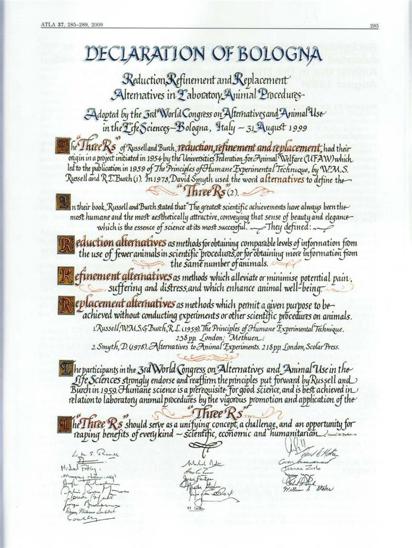
Dissemination of resources on how to implement the 3Rs should be one of the pillars of all scientist's work:
Thanks for your feedback! Please note that we cannot reply to you unless you send us an email.
What are you looking for?
We value your feedback so we can improve the information on the page. Please add your email address if you would like a reply. Thank you in advance for your help.!
Please contact us by email if you have any questions.


